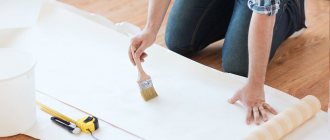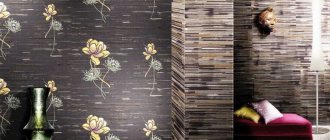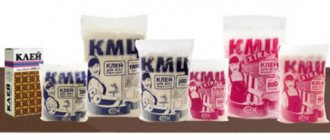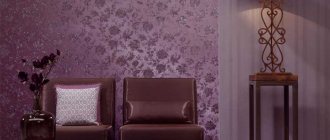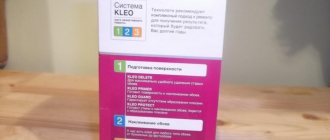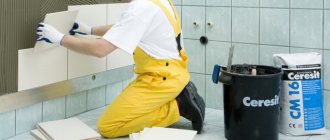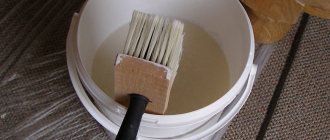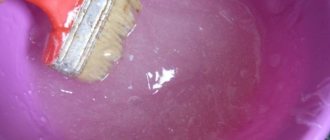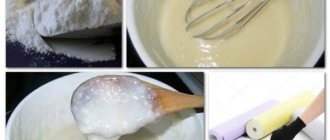Secrets of pasting
Due to the unique composition and texture of non-woven wallpaper, glue plays a major role in a good and durable gluing result. A good and professional glue should have the following qualities:
- lie evenly on the wall;
- have the appropriate density after dilution, suitable for the density of non-woven wallpaper;
- form joints well and provide the opportunity to correct the position of the canvas if a mistake was made;
- should not contain coloring substances.
These are the qualities that Kleo adhesive for non-woven wallpaper has.
Tools for work
Like any other wallpaper glue, Kleo is diluted according to the standard scheme. Therefore, to prepare it you will need a standard set of tools and a deep container.
- Deep container with a volume of at least 5 liters. An enamel or plastic bucket, basin or large saucepan is perfect for this purpose; then you can easily mix the solution evenly without splashes or drips;
- For stirring, any device for such purposes, which can be purchased at a hardware store, is suitable. You can also take an ordinary kitchen wooden spatula or a thick stick. The ideal equipment for kneading is a construction mixer. If you have one at home, then you don’t have to worry about the uniformity and consistency of the wallpaper glue. A drill with a paddle attachment will also work;
- water at room temperature, never hot;
- a paint brush or soft roller for applying glue after thinning to the wallpaper;
- a damp cloth or spatula with a soft base for smoothing and removing residual glue from under the wallpaper.
What should quality glue guarantee?
The repair can be considered successful if three factors are met:
- high-quality wallpaper;
- properly prepared walls;
- suitable glue.
When all conditions are combined, even a beginner can cope with wallpapering a room - all you need is tools and a little care.
When choosing an adhesive for installing non-woven wallpaper, you must take into account its type and operating characteristics. Thus, wallpaper with a top vinyl layer and a non-woven backing is heavy. This is a very heavy and dense wallpaper when compared to paper. For such coatings, a special adhesive marked “for heavy wallpaper” is required. Even a universal mixture, according to the manufacturer, suitable for any type of wallpaper, will not withstand the weight of multilayer vinyl. Wallpaper may peel or become warped.
Fully non-woven coverings are not as heavy as they are bulky. They can be glued with universal glue. But! If you plan to use non-woven wallpaper in conditions of high humidity or possible temperature changes, it is better to choose glue specifically for non-woven wallpaper. This is what Kleo Extra is. It contains antiseptic additives designed to destroy microorganisms under the wallpaper layer. Mold will not grow on the walls and fungus harmful to health will not multiply.
The same rule applies to non-woven fabrics intended for painting. After applying the paint, the wallpaper will become much heavier; universal glue may not support its weight. Another nuance is the transparency of the composition. After drying, Cleo glue for non-woven fabric becomes completely transparent. Therefore, drops of glue that accidentally fall on the front side of the coating will not affect the uniformity of coloring.
How to choose the right glue?
The glue is selected for each wallpaper individually. If you purchase paper wallpaper, you don’t have to think too much about glue; any will do. When purchasing non-woven or vinyl wallpaper, you need a special one for this type of wallpaper. All this is due to the fact that this type of wallpaper requires a strong and thick mixture. To dilute the glue as well as possible, you must refer to the included instructions.
Advantages of Cleo glue
It is Cleo glue that brings with it numerous positive reviews from professional and experienced pasters. It is preferred by both professionals and those who are faced with wallpapering walls for the first time, due to its ease of use, unique composition and low price. Kleo glue contains the following components:
- modified starch;
- numerous fastening additives;
- antifungal components.
The high-quality composition is characterized by high quality adhesion and universal adhesive properties. In addition, Kleo Extra adhesive for non-woven wallpaper has a number of other advantages, which sets it apart from rival brands:
- economy - one standard pack can be enough for 30 m2;
- favorable price available to every buyer;
- when diluted, Cleo Extra has a transparent and uniform texture, which makes it quick and easy to apply to walls;
- low consumption;
- the ability to maintain its adhesive properties for up to 10 days after dilution;
- strong and durable fixation of wallpaper;
- does not leave stains on the surface of non-woven wallpaper.
Cleo glue is sold in branded cardboard packaging, which contains detailed instructions for use and dilution, has a powdery appearance and is packaged in dense sealed polyethylene. There are many varieties with different weights and packaging, but all reviews about the quality of the products, regardless of the type, are positive.
Cleo adhesive range
The assortment of the Cleo company is huge. Materials are created for completely different conditions and types of wallpaper. This careful approach allows you to get the best results. Wallpaper glue Cleo Optima is designed for gluing paper wallpaper. Not suitable for heavier sheets. It is applied directly to sheets of wallpaper; adjustments to the position on the wall must be made within 2 minutes after application to the surface.
Wallpaper glue Cleo Optima is designed for gluing paper wallpaper.
Smart is designed for vinyl flooring. It has a more secure fit, allowing you to hold more weight. After cooking, you need to wait 5-7 minutes, and only then cover the material with it.
It has a more secure fit, allowing you to hold more weight.
Kleo extra glue is suitable for non-woven wallpaper, one of the most durable compounds. Colorless and odorless, which is convenient for working with light shades of canvas. It dries quickly, application of coloring solutions is allowed after 2-3 hours.
Kleo extra glue is suitable for non-woven wallpaper, one of the most durable compounds.
Ultra is designed for the heaviest and densest wallpapers. Can be used with glass wallpaper, fiberglass, vinyl and fabric types of finishing materials.
Ultra is designed for the heaviest and densest wallpapers.
Kids, from the name it is clear that the glue is designed to work in children's rooms. Has a neutral pH level. Can be used with any types of fabrics. The finished composition can be applied to cut sheets of wallpaper after 7 minutes.
Has a neutral pH level.
Deluxe is intended for covering heavy structures. Sold in a single package, glue and primer composition are durable and reliable.
Deluxe is intended for covering heavy structures.
Strong is designed to create enhanced hold. Typically used for gluing joints and decorative parts. Strength is ensured due to a special composition; it is sold ready-made in small tubes. It is thick and does not form cracks or peel off.
Typically used for gluing joints and decorative parts.
Border also comes in tubes and is thick. Used for gluing border wallpaper; convenient packaging makes it easy to apply it to the material.
Convenient packaging makes it easy to apply them to the material.
Photo is used for gluing photo wallpaper. The basis of the composition makes it possible to adjust the position of the paintings on the wall, while keeping them intact. Does not leave stains.
The basis of the composition makes it possible to adjust the location of the paintings on the wall.
Total 70 is a universal adhesive suitable for different types of coatings. Dries quickly and has no odor.
Total 70 is a universal adhesive suitable for different types of coatings.
Nature is produced for gluing expensive types of wallpaper: velor, textile, bamboo, felt. It is safe and can be applied to the wall.
Nature is produced for gluing expensive types of wallpaper.Line special is also universal and has a strengthened formula.
Line special has a strengthened formula.
Professional. Professionals work with it and it is suitable for a variety of materials.
Professionals work with it and it is suitable for a variety of materials.
Material characteristics
It’s not for nothing that Cleo wallpaper glue is so in demand on the building materials market. Its special characteristics determine the choice of many professionals and beginners in favor of it. The following characteristics are distinguished:
- Moderate cost;
- Lump-free and smooth application;
- Quick readiness, in 5 minutes;
- Excellent sliding properties, moving the canvas will not be difficult;
- Ease of further dismantling work;
- Transparency;
- You can paint the walls after gluing in two hours;
- Neutral pH level, which allows the composition not to cause allergic reactions in people.
Special characteristics determine the choice of many professionals and beginners in favor of it.
Material characteristics
If you dilute the product strictly according to the instructions, it will have the desired thickness and is ideal for non-woven wallpaper. The glue is evenly applied to the wall and firmly fixes the wallpaper; after drying, the joints do not separate from the surface. The main properties of the material are:
- neutral acid-base environment;
- high moisture resistance (you can glue wallpaper in damp rooms);
- uniformity of the solution, absence of foreign inclusions, lumps;
- the solution is ready in 5 minutes;
- optimal sliding properties (wallpaper can be moved after being applied to the wall);
- quick drying (wallpaper can be painted 2 hours after gluing the canvas).
Treatment with adhesive solution
The glue must be applied not to non-woven wallpaper, but to the walls! To do this, use a brush or roller. It is recommended to have both of these devices in your arsenal, and operate them depending on accessibility to the locations.
Hard-to-reach places, such as joints, corners, areas near baseboards, are usually treated with a brush, and spacious rooms - with a roller. The layers of glue must be applied evenly, since due to the transparency of CLEO glue it is very difficult to follow.
To avoid missing areas, renovation amateurs are advised to first draw lines on the wall with a pencil according to the width of the canvas. In fact, the procedure for gluing non-woven wallpaper is not that complicated.
The main thing is to follow this order:
- start gluing the wallpaper, leaving a space of forty centimeters from the edge of the window (to be sure, it is better to draw a vertical line along the plumb line);
- apply glue to the wall, and apply the first strip of canvas along the drawn line (usually, experienced specialists paste walls from a roll);
- Carry out the same procedure for subsequent strips, while keeping an eye on the joints; if necessary, you can carefully brush the joints with a thin brush.
“Before starting work, it is necessary to close the room to avoid drafts, and the temperature was from +10 to +25 degrees (this way the glue can dry evenly).”
Instructions for use
The method of diluting the dry mixture of Kleo glue is not much different from other adhesives. Before you start breeding, you need to prepare everything so that this process does not cause any difficulties.
So, the first stage is the preparation of inventory and working tools. To prepare Kleo glue you will need a deep container with a volume of 7 to 10 liters. An enamel or plastic bucket, basin, pan will play this role well. You should also take care of the tool that will be used to thoroughly knead. You can mix the glue thoroughly without leaving any lumps using a special construction mixer, which comes with paddle attachments. If you don’t have one, then a store-bought spatula or a wide wooden stick will do.
- Next, you should prepare water for diluting Cleo glue; it should be at room temperature and in the volumes indicated on the box;
- after this, pour the dry mixture into a container with water in a light stream, and do not forget about regular stirring to avoid the formation of lumps;
- the prepared mixture should be left to rest and soak well for about 5 minutes;
- then mix thoroughly again with a mixer or spatula.
Upon completion of all these simple procedures, Kleo adhesive for non-woven wallpaper is ready to be applied to the wall.
Choosing glue for non-woven wallpaper
When planning to cover walls in a residential or office space with non-woven wallpaper, you must not only choose rolls with a beautiful pattern, but also decide on the composition of the adhesive. Modern technologies allow manufacturers to satisfy consumer demand as widely as possible. Kleo is a well-established brand of wallpaper glue, distinguished by its quality characteristics and cost-effectiveness.
Its consistency is thicker than that of the standard mixture, diluted according to all the rules. This allows the substance not to be absorbed into the base after several hours of drying. It does not change color, does not turn yellow, becoming completely transparent.
This adhesive for non-woven wallpaper Kleo allows you to work with consumables in conditions of increased comfort, without fear of spoiling the expensive facing material. This is important when working with thin and translucent wallpaper rolls, as in the photo. Sudden yellowness is difficult to disguise or wash off later. With a substance such as Kleo glue, such problems do not threaten even beginners who have decided to try themselves in this field for the first time, the main thing is to dilute it correctly.
Auxiliary materials for diluting glue (instructions)
- First of all, you must choose a convenient and sufficiently large container for dilution. This can be a plastic bucket, enamel or plastic basin (approximate capacity - at least 5 liters for good stirring).
- Any tool suitable for stirring Kleo glue - in the absence of special tools, you can get by with an ordinary wooden stick of the required length. But this will complicate the process to some extent, your hands will quickly get tired, and a uniform consistency may not be achieved.
The ideal option for mixing glue is a construction mixer, which can be purchased at any store, or a drill with a special paddle attachment. Powered by electricity, the tool allows you to turn water and dry glue into the desired mixture in just 5 minutes. As a last resort, you can take a regular mixer used in the kitchen, which is used at low speed.
Kleo wallpaper glue from the manufacturer (not a fake) for non-woven wallpaper does not contain any harmful substances, but precautions must be strictly observed. After finishing work, the tool must be washed with special care using a sponge and hot water, adding standard dishwashing detergent to the solution.
- Kleo has a special structure. To apply it, you must use a paint roller or brush, which should be at hand during the stirring process. The substance must be applied quickly. Repair experts say that using a roller is much more convenient - the layer of glue will be uniform.
- Water – can be used for dilution, either cold or at room temperature. The versatility of the Kleo wallpaper composition in this matter is confirmed by many user reviews.
- Adhesive composition for non-woven wallpaper.
You need to dilute the glue slowly to avoid the appearance of lumps, as in the video. The instructions were created in order to avoid trivial mistakes that will lead to a disappointing outcome. Reviews indicate that the Kleo brand of glue, currently popular among builders, has all the advantages of high-quality material.
The importance of the preparation phase
In order for Cleo glue to set well and securely fasten the non-woven wallpaper to the wall, you should pay special attention to the surface preparation stage. First you need to conscientiously clean the wall of old wallpaper, paint, and plaster. After this, you need to start leveling the surface with plaster.
For good adhesion of the wallpaper, it is necessary to prime the wall. After completing this work and waiting for the primer to dry, you can begin gluing the walls with non-woven wallpaper.
Instructions for use of dry adhesives “Kleo”
Powder adhesives are prepared according to the same principle. It is necessary to prepare a container with the required amount of water, then carefully gradually pour the powder into the water with constant stirring. You need to pour not in the center, but near the edge of the container. To stir, you can use a special whisk attachment on a drill, as shown in the video.
After this, the composition is left for the required time to swell. It varies for different types of glue, but does not exceed 7 minutes. Then the glue is mixed again, and you can start gluing. The swelling time of different types of glue, according to the instructions, is as follows:
- “Kleo Photo, Optima” - 3 minutes,
- “Kleo Nature, Extra Non-woven, Ultra, Total” - 5 minutes,
- “Kleo Kids, Smart Vinyl, Smart Vinyl with Indicator” - 7 minutes.
To get a good result, the surface must be prepared: cleaned of old wallpaper, primed. To do this, you can use Anti-Wallpaper and Kleo primer.
Proportions of glue and water
Depending on the type of Kleo adhesive and decorative coating, the ratio of glue to water will be different.
- “Nature” - 3.5 liters per 100 g pack for natural coatings and 3 liters for other types (metalized, heavy, structured, frescoes).
- “Total 70” - 13 liters per pack of 500 g for paper and light vinyl, 12 liters - for non-woven vinyl, 11 liters - for non-woven fabric for painting, 10 liters - for very heavy coatings, silk-screen printing.
- “Extra Non-woven” - 6 liters per package of glue.
- “Ultra” - 3.5 liters per 250 g for fiberglass, 5 liters per 250 g for non-woven fabric, vinyl, special wallpaper.
- “Smart Vinyl” - 7 liters per 200 g for light vinyl, 6 liters per 200 g for heavy vinyl.
- “Kids” - 3.5 liters per 100 g package for light single-layer paper, 3 liters for thick two-layer ones.
- “Photo” - 4.5 liters per 85 g package for light vinyl, 4 liters for heavy vinyl, 3 liters for velor, 2 liters for polystyrene foam tiles.
- “DeLuxe” - for very heavy wallpaper - 8 liters per pack, for other dense types - 8.5 liters, for paper - 10 liters.
- “Optima Paper” - 4.5 liters per pack of 120 g for light paper, 4 liters for two-layer ones.
How long will a pack of glue last?
Kleo wallpaper adhesive is available in packages of different sizes, ranging from 85 to 500 g, so you can glue different amounts of wallpaper. A standard roll has dimensions of 10.03 by 0.53 m, there are also “meter” rolls with a width of 1.06 m, that is, the area of a regular roll is about 5.3 or 10.6 square meters. m. Exclusive wallpapers come in other formats. How long will each type of Kleo package last?
- “Extra Non-woven” - for 30-35 sq. m.
- “Ultra” - a pack of 250 g is enough for 25 square meters. m.
- "Optima" - a pack of 120 g is enough for 25-30 sq. m (5-6 rolls) of light paper or for 20-25 sq. m (4-5 rolls) heavier.
- “Kids” - 4-5 rolls depending on the density of the wallpaper.
- “Smart Vinyl” - a pack of 200 g for 7-9 rolls.
- "Photo" - up to 12 sq. m.
- "DeLux" - enough for 7-8 regular rolls
- “Total 70” - a pack of 500 g is enough for 50-65 sq. m.
- "Nature" - for 11-15 sq. m.
- “Ultra ready” - consumption 200-330 g per sq.m.
How to calculate consumption
The solution is sold in different volumes, so it is often necessary to calculate the required amount of powder. A package of 100-150 g is usually enough for 20-35 m2 . The cost of dense and heavy materials increases, which must be taken into account before purchasing. Gluing a standard canvas 1.06 m wide and 10 m long will require from 40 g to 120 g of solution. Before purchasing glue, you need to calculate the total area that goes under the wallpaper and decide on the type of powder. After this, make the necessary calculations.
Application of adhesives - instructions
In order to dilute the glue, you need to prepare a container of 5 liters or more (basin, bucket, pan). To stir, take a wooden stick, a spatula, the best option is a construction mixer. Take water strictly at room temperature; hot water will spoil the composition. For subsequent application you will need rollers and a brush.
Correct breeding
How to dilute powder adhesives of this brand? The instructions for use will be the same, but the proportions will vary depending on the specific material. They are indicated in the instructions and must be strictly followed. The operating procedure is as follows:
- pour the required amount of water into the container,
- slowly add the powder in small portions, stirring thoroughly,
- pour the composition along the edges of the container, not in the center,
- after final mixing, leave the swelling agent for 3-7 minutes, as indicated in the instructions,
- Stir the glue again and get to work.
Material consumption
Packages of Kleo brand products vary in volume. The consumption will also vary depending on the specific type of glue. On average, gluing a standard roll 1.06 m wide and 10 m long requires 40-120 g of glue. Heavy canvases require much more material than light ones. One pack of product is usually enough for 20-35 square meters. m of area, the finished glue has a higher consumption.
You should calculate in advance the expected area of pasting, select the desired type of glue and determine the required quantity. This will avoid the problem of running out of funds during operation.
How to use it correctly
The soft texture of Kleo adhesive for non-woven wallpaper easily lays on a flat surface, so a soft paint roller or a wide whitewash brush is best for application.
Using any of these tools, you can quickly apply glue to a previously prepared surface.
After which you can start gluing the wallpaper itself, which has previously been cut into strips of the required length. It is best to work in pairs, because, despite the ease of applying Cleo glue, non-woven wallpaper is heavy. In addition, you need clear control over the gluing process so that the joints fit together well.
You can smooth the wallpaper with a soft spatula or a damp piece of cloth. Excess Cleo glue released from under the joints must be removed with a wet rag. The transparent composition leaves no traces, has no suspicious odor and is easily removed from the canvas.
More information about Cleo glue can be found in the video:
Instructions for using Kleo glue
Before diluting the glue, it is necessary to prepare a suitable container. A basin or wide bucket is perfect for this. You will also need a tool that can be used to easily stir the mixture until it reaches a homogeneous consistency. This role can be performed by a drill with a “construction mixer” type attachment or an ordinary wooden stick, but only a clean and dry one. In order for the solution to be correct, it is necessary to observe the proportions, which are indicated in detail on each pack of glue.
It is important to thoroughly stir the dry powder during and after dilution to prevent lumps from forming. Thanks to the homogeneity of the adhesive composition, the wallpaper will lie flat without the formation of bubbles and wrinkles
Important! Even though Kleo glue can be stored diluted for 10 days, it is better to dilute it in small portions.
But, before purchasing and diluting the adhesive composition, it is worth calculating the amount of it that will be required to cover the desired area. To do this, from the area of the room it is necessary to calculate the total area of windows, doors and other elements that do not require gluing. Sometimes it is calculated by specifying the area of the walls that need to be completely covered with wallpaper and identifying the surface that is not completely covered with it. Glue consumption per 1 sq. meter is always indicated on the packaging, so the area of the room will be sufficient.
Important! It is better to buy a little more adhesive composition, since during the gluing process, residues are obtained that are not used, for example, when coating the canvas on the floor, or excess, which is removed with a clean rag.
It is very important to pay special attention to preparing the surface before gluing wallpaper. It is necessary to carefully remove the previous finishing material, be it paint, wallpaper or plaster. After this comes the leveling stage, which can be done with special plaster or by installing plasterboard sheets on the walls.
In order to make adhesion even stronger, you need to prime the walls with a special solution
After this comes the leveling stage, which can be done with special plaster or by installing plasterboard sheets on the walls. In order to make adhesion even stronger, you need to prime the walls with a special solution.
Thanks to its soft structure, Kleo adhesive is applied with a roller or whitewash paint brush. Any of these tools will allow you to quickly apply glue to the surface of the wallpaper.
After this you can start gluing. To simplify the work, it is best to immediately cut the wallpaper into strips, the length of which will be identical to the height of the areas being pasted. It is optimal to work in pairs, since non-woven wallpaper is heavy, which will be difficult for one person to handle
In addition, it is important to control the joints along the entire length of the wallpaper.
Smooth the wallpaper with a slightly damp cloth or soft spatula. Excess glue that comes out from under the joints is removed with a damp sponge or cloth. Due to its transparency, the composition does not leave any traces on the wallpaper after removal.
The weak points when decorating walls with wallpaper are the joints. This usually happens when gluing the panels end-to-end, as the edges are not properly saturated and dry out quickly. To correct loose areas, a special glue for joints has been invented, which is sold in tubes with a narrow spout so that it can be used in hard-to-reach places. An example of such a composition is KLEO STRONG, which is suitable for decorating walls in corners and even behind heating radiators.
Composition of Methylane glue
Methylane wallpaper glue is sold in granular form in hermetically sealed packages. Mixture composition:
- methylcellulose or modified starch;
- effect enhancing components;
- antifungal additives.
The version with methylcellulose is distinguished by an increased price, a greater degree of strength, absence of odor, and resistance to temperature changes. Correction of joints is allowed in the first 15 minutes. It is Methylane adhesive for non-woven wallpaper made of methylcellulose that is suitable for treating cemented, limestone surfaces (walls).
A technical feature is a color indicator, which controls the uniformity of the applied layer on both canvases and walls.
What is it and why
Paste is a homemade glue made from flour or starch mixed with water. Despite the abundance of various adhesives on sale, homemade glue is widely used in repair work and everyday life.
The most common areas of application are:
- Wallpapering. For large volumes of work, using paste will significantly reduce repair costs. At the same time, the quality is not inferior to store-bought formulations.
- Window pasting. It will help get rid of drafts without damaging the materials.
- Primer of walls. The mixture is perfect for preparing walls for finishing.
- Preparing seeds for sowing. To distribute the seeds evenly, they are glued to toilet paper before planting in the garden bed. The natural adhesive will not harm the seeds.
- Children's creativity. Hypoallergenic and not dangerous if swallowed, the homemade composition is well suited for working with children.
- Needlework. Craftswomen use it for scrapbooking, fabric compositions, and papier-mâché.
Making your own glue is not at all difficult. Most often, flour and water need to be boiled and cooked for some time, but there are recipes without cooking, when the flour is diluted with a small amount of cold water and boiling water is added to the resulting mixture.
The main advantages of homemade glue are its cost and safety for health, because it is prepared from natural ingredients. The disadvantage is that it does not last long in storage, so it is boiled immediately before the planned work in a volume sufficient to complete the task.
For wallpaper
Flour glue is suitable for both thick and thin vinyl wallpaper, only the proportions of the components and the thickness of the resulting mixture are different. To make the paste, take the cheapest flour, since it contains more gluten due to rougher processing, which means it will be better to keep such a composition.
What additives to the adhesive solution are used when gluing wallpaper:
- PVA. Improves characteristics, increases adhesion.
- Wood glue. Improves fixing properties, not suitable for light-colored wallpaper - stains may appear. Use exclusively for dark wallpaper.
- Copper sulfate. A small amount is enough to prevent parasites.
Household glue is good for gluing windows with wooden frames, the cracks in which can be perfectly closed with a mixture of water and flour.
Papier mache
Papier-mâché is a popular technique for making paper and glue crafts because the source material is readily available and the final product is light and durable. To work in the papier-mâché technique, you do not need special knowledge or education; the result is limited only by the author’s imagination. Papier-mâché is used for interior design decoration, as a hobby, in children's creativity, for making masks and theatrical props.
Needlework
Glue made from water and flour is widely used by needlewomen. For example, fabric is impregnated with it when making artificial flowers. To work with fabric, vanillin is added to the wallpaper paste; it will add shine to the finished product.
Semin
Another French company founded in 1838. Its products were introduced to the Russian market in 1996. The company produces products at three factories, one of which is located in Russia.
Wallpaper glue from this manufacturer is represented by a narrower range than that of the above companies; the brand’s product has been highly appreciated by Russian consumers for its excellent quality. It’s a pity that even in Moscow you can’t buy it in all stores. Non-woven wallpaper glue and dry mixture for textile wallpaper from this company are especially popular.
